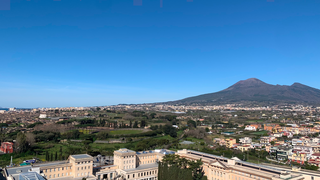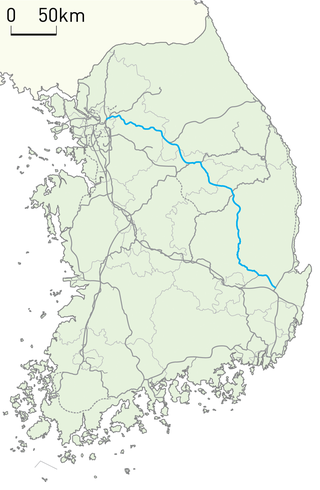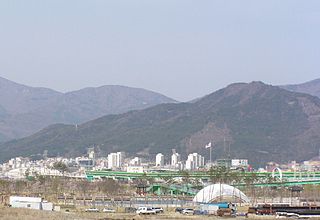
Pompei or Pompeii is a city and commune in the Metropolitan City of Naples, Italy, home of the ancient Roman ruins of Pompeii that are part of the UNESCO World Heritage Sites.

North Gyeongsang Province is a province in eastern South Korea, and with an area of 19,030 km2 (7,350 sq mi), it is the largest province in the Korean peninsula. The province was formed in 1896 from the northern half of the former Gyeongsang province, and remained a province of Korea until the country's division in 1945, then became part of South Korea.

Jinhae-gu is a district in Changwon City, South Korea. This region is served by the Korean National Railroad, and is famous for its annual cherry blossom festival every spring.

Gyeongju, historically known as Seorabeol, is a coastal city in the far southeastern corner of North Gyeongsang Province, South Korea. It is the second largest city by area in the province after Andong, covering 1,324 km2 (511 sq mi) with a population of 264,091 people as of December 2012. Gyeongju is 370 km (230 mi) southeast of Seoul, and 55 km (34 mi) east of Daegu. The city borders Cheongdo and Yeongcheon to the west, Ulsan to the south and Pohang to the north, while to the east lies the coast of the Sea of Japan. Numerous low mountains—outliers of the Taebaek range—are scattered around the city.

The Jungang line is a railway line connecting Cheongnyangni in Seoul to Moryang in Gyeongju in South Korea, traversing central South Korea from the northwest to the southeast. It is also referred to as the rail line of the Seoul Metropolitan Subway from Yongsan station to Jipyeong station. The section from Cheongnyangni to Dodam was designated as a semi-high-speed railway.

The Donghae Nambu Line (Korean: 동해남부선) is a railway line connecting Busan to Pohang in South Korea. The line runs along South Korea's east coast. On December 30, 2016, it was merged into Donghae Line.

The Daegu Line is a railway line in South Korea. The line connects Gacheon station on the Gyeongbu Line in Daegu to Yeongcheon on the Jungang Line. The line is served by frequent passenger trains between Seoul, Dongdaegu, and Gyeongju, Pohang and Ulsan.

Yangsan is a city in Gyeongsangnam-do Province, South Korea.

The Hyeongsan River is a river in southeastern South Korea. It flows from Baeyanggol Valley (배양골), Wolpyeong-ri (월평리/月坪里), Dudong-myeon (두동면/斗東面), Ulju County in Ulsan to the Sea of Japan, covering a distance of about 62 km. The Hyeongsan watershed covers roughly 1,167 km2.
Namsan is a mountain in Seoul, South Korea.
The primary subdivisions of Gyeongju in South Korea consist of 4 eup, 8 myeon, and 11 dong. These units are the same into which all of the cities and counties of South Korea are divided. The dong units occupy the area of the city center, which was formerly occupied by Gyeongju-eup. Eup refers to a substantial village, whereas the myeon are more rural. The current divisions are as follows, using the numbers given on the map:

Hwangnam bread, also commonly called Gyeongju bread, is a local specialty of Gyeongju City, South Korea. It is a small pastry with a filling of red bean paste. Gyeongju bread was first baked in 1939 at a bakery in Hwangnam-dong in central Gyeongju.

Gyeongju Korea Hydro and Nuclear Power FC or simply Gyeongju KHNP is a South Korean football team based in Gyeongju. They currently compete in the K3 League. They are run by Korea Hydro & Nuclear Power, and play their home games at Gyeongju Civic Stadium.

Seoul, the capital of South Korea, has been called by a number of formal and informal names over time. The word seoul was originally a common noun that simply meant "capital city", and was used colloquially to refer to the capital throughout Korean history. Seoul became the official name of the South Korean capital after its liberation from Japan after the Second World War.

Gangdong-myeon is a myeon or a township of Gyeongju city in North Gyeongsang Province, South Korea. It is bordered by Pohang on the east and north, Cheonbuk-myeon on the south and Angang-eup on the west. In 2006 its population was 8,705 people, and its area is approximately 81.48 sq kilometers. Its name means "east of the river" although in fact much of it lies north of the Hyeongsan River.

Gyeongju station is a station near the city of Gyeongju. It is on the Gyeongbu KTX Line and Donghae Line. Its former name Singyeongju station means "new Gyeongju station".

Angang-eup is an eup, or town, and the second-largest subdivision of Gyeongju City. Its 139 square kilometers are home to about 33,300 people and is served by six elementary schools and two joint middle-high schools. Situated next to Gangdong-myeon in the city's northern tip, it is a significant town in its own right. Angang Station is a regular stop on the Donghae Nambu Line. The town center lies on the Hyeongsan River, near where it meets the small Chilpyeongcheon stream. Important local products include rice, apples, and grapes.

The Donghae Line is a railway line connecting Busanjin station to Yeongdeok in South Korea. The literal meaning of its name, the "East Sea Line," reflects its position along the nation's East coast. It merged with the Donghae Nambu Line on December 30, 2016, and will merge with the Donghae Bukbu Line.
The 2020 WK League was the twelfth season of the WK League, the top division of women's football in South Korea. The regular season ran from 15 June to 15 October 2020. Due to the COVID-19 pandemic, the total amount of rounds were reduced from 28 to 21.

Moryang station is a railway station of the Donghae Line and Jungang Line in Gyeongju, North Gyeongsang Province, South Korea.

















